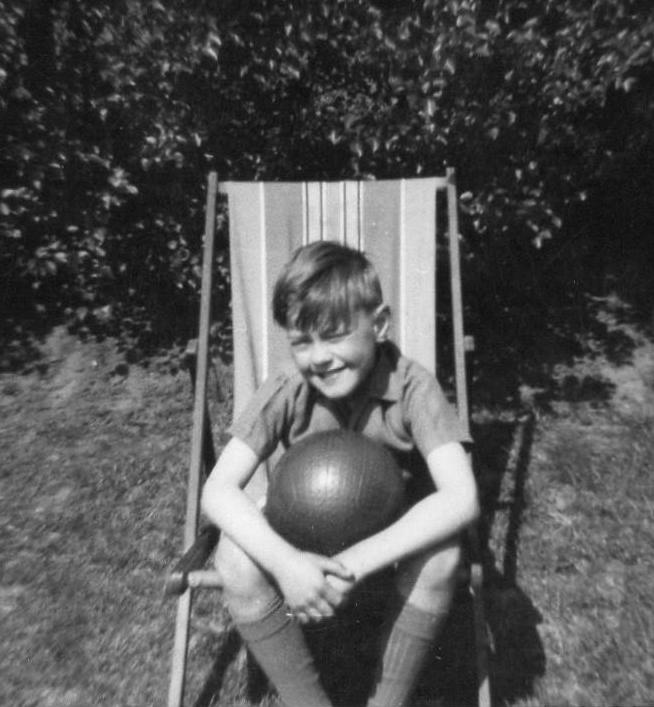
English Boys' Hosiery Types: Knee Sock Chronology--The 20th Century

Figure 1.-- Knee socks gnerally became seasonal wear in England. Even so, ome boys wore them during the ummer. Here we see an English boy in a back garden deck chair and holding a ball during his summer vacation. The family snapshot is undated, but looks like it was taken about 1960, probably in his back garden.
|
|
We note many boys wearing knee socks pulled up with knee pants in the early-20th century. The knee was covered, but barely. We are unsure whether to call this hosiery knee socks knee socks or long stockings. But in fact, turn-over-top knee socks were essentially the same as long sockings, especilly when boys were wearing knee pants or long short pants. In fact the English had different terms over time, including long socks and school socks. Knee socks were common in England right from when short trousers became the common fashion after World War I in the 1920s. Long stockings virtually disappeared for boys, but some girls still wore them. English boys commonly wore knee socks throughout the inter-War era. This was usually turn-over-top socks. We begin to see boys wearing ankle socks during the summer in the 1930s, but this needs to be confirmed. Boys wearing sandal might wear them without socks. The knee socks with patterns at the top generally disappear by the 60s, but school socks with color tops or bars become increasingly popular.We note cheaper knee socks appearing in the 1950s, especially the late-50s. These were knee socks that just cane to the knee and did not have the extra turn-over-top bit or cuff. They were also often lighter weights. These becme popular for children at state schools, many of which began requiring uniforms. Knee socks continued to be common into the 1960s. By the 1970s, short trousers and knee socks became more associated with schoolwear and Cubs. Tube socks were popular for a while. By the end of the century, boys no longer wore knee socks to any extent and they had even begun to decline as schoolwear, in part because fewer boys were wearing shorts to school. By the 80s we rarely see boys wearing knee socks excpt as part of school or Cub uniforms.
The 1900s
We note many boys wearing knee socks pulled up with knee pants in the early-20th century. The knee was covered, but barely. We are unsure whether to call this hosiery knee socks or long stockings. But in fact, turn-over-top knee socks were essentially the same as long sockings, especilly when boys were wearing knee pants or long short pants. In fact the English had different terms over time, including long socks and school socks.
The 1920s
Knee socks were common in England right from when short trousers became the common fashion after World War I in the 1920s. Long stockings virtually disappeared for boys, but some girls still wore them. English boys commonly wore knee socks throughout the inter-War era. This was usually turn-over-top socks.
The 1930s
We continue to see boys wearing knee socks in the 1930s. Boys of all ages wore short pants and knee socks. This included younger teenagers. A good example is Ken Adams. This varied from family to family. We note knee socks with patterned tops. We begin to see boys wearing ankle socks during the summer in the 1930s, but this needs to be confirmed. Boys wearing sandal might wear them without socks.
The 1940s
The 1950s
We note cheaper knee socks appearing in the 1950s, especially the late-50s. These were knee socks that just cane to the knee and did not have the extra turn-over-top bit or cuff. They were also often lighter weights. These became popular for children at state schools, many of which began requiring uniforms.
The 1960s
Many boys wore turn-over-top knee socks (figure 1), but the shortr style without the extra length were becoming increasingly common. Knee socks continued to be common into the 1960s. The knee socks with patterns at the top generally disappear by the 60s, but school socks with color tops or bars become increasingly popular.
The 1970s
By the 1970s, short trousers and knee socks became more associated with schoolwear and Cubs. Tube socks were popular for a while. By the end of the century, boys no longer wore knee socks to any extent and they had even begun to decline as schoolwear, in part because fewer boys were wearing shorts to school.
The 1980s
By the 80s we rarely see boys wearing knee socks excpt as part of school or Cub uniforms.
HBC

Navigate the Boys' Historical Clothing Web Site:
[Return to Main English knee socks chronology page]
[Return to Main English knee socks page]
[Return to Main English hosiery type page]
[Return to Main knee sock country page]
[Return to Main English hosiery page]
[Return to Main English garment page]
[Introduction]
[Activities]
[Biographies]
[Chronology]
[Clothing styles]
[Countries]
[Photography]
[Topics]
[Bibliographies]
[Contributions]
[FAQs]
[Glossaries]
[Images]
[Links]
[Registration]
[Tools]
[Boys' Clothing Home]
Created: 4:36 AM 5/27/2014
Last updated: 9:57 AM 10/14/2014



